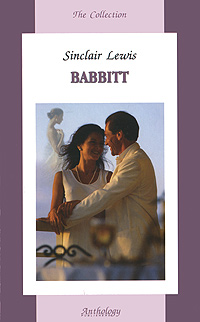Книга: Sinclair Lewis «Babbitt»

|
Серия: "The Collection" "Бэббитт" - роман, имя главного героя которого, Джорджа Бэббитта, стало нарицательным. Это собирательный образ американского преуспевающего мещанина лишенного индивидуальности, с несколько ограниченным духовным миром, которого, несмотря на материальное и семейное благополучие, терзают тоска и неудовлетворенность жизнью. Издательство: "Антология" (2005) Формат: 84x108/32, 352 стр.
ISBN: 5-94962-103-4 Купить за 93 руб на Озоне |
Другие книги автора:
| Книга | Описание | Год | Цена | Тип книги |
|---|---|---|---|---|
| Babbitt (изд. 2005 г. ) | Бэббитт - роман, имя главного героя которого, Джорджа Бэббитта, стало нарицательным. Это собирательный образ… — Антология, (формат: 84x108/32, 352 стр.) The Collection Подробнее... | бумажная книга |
Sinclair Lewis
Infobox Writer
name = Sinclair Lewis

birthname = Harry Sinclair Lewis
birthdate = birth date|1885|2|7|mf=y
birthplace =
deathdate = death date and age|1951|1|10|1885|2|7|mf=y
deathplace =
occupation =
nationality = American
awards = awd|
Sinclair Lewis (
Biography
Boyhood and education
Born Harry Sinclair Lewis in the village of
Early career
Lewis's earliest published creative work—romantic poetry and short sketches—appeared in the "Yale Courant" and the "
Commercial success
Upon moving to
url=http://www.nybooks.com/articles/2805
title=The Romance of Sinclair Lewis
publisher=The New York Review of Books
accessdate=2008-06-17
] As his biographer
He followed up this first great success with "Babbitt" (1922), a novel that satirized the American commercial culture and
Lewis' success in the 1920s continued with "Arrowsmith" (1925), a novel about an idealistic doctor which was awarded the Pulitzer Prize (which he refused). The controversial "
Lewis also spent much of the late 1920s and 1930s writing short stories for various magazines and publications. One of his short stories published in "Cosmopolitan" magazine was "Little Bear Bongo" (1936), a tale about a bear cub who wanted to escape the circus in search of a better life in the real world. [cite web
url=http://www.toonopedia.com/bongo-b.htm
title=Bongo Bear
publisher=Don Markstein's Toonopedia
accessdate=2008-01-26
See also [http://www.pwpl.org/collections/special/SinclairLewis/sl-08.html Film Posters and Ephemera] and [http://www.pwpl.org/collections/special/SinclairLewis/sl-06.html Lewis Manuscripts / Miscellania] at the Port Washington Public Library.] The story was acquired by
Nobel Prize
In 1930, Lewis won the Nobel Prize in Literature in his first year of nomination. In the
Later years
After winning the Nobel Prize, Lewis published nine more novels in his lifetime, the best remembered being "
Lewis died in Rome on
ee also
*
*
Bibliography
* "Hike and the Aeroplane" (1912) (as Tom Graham)
* "Our Mr. Wrenn" (1914)
* "The Trail of the Hawk" (1915)
* "The Innocents" (1917)
* "The Job" (1917)
* "
* "Main Street" (1920)
* "Babbitt" (1922)
* "Arrowsmith" (1925)
* "Mantrap" (1926)
* "
* "The Man Who Knew Coolidge" (1928)
* "
* "
* "Work of Art" (1934)
* "
* "Jayhawker" (1935) (play)
* "Selected Short Stories" (1935)
* "The Prodigal Parents" (1938)
* "Bethel Merriday" (1940)
* "
* "
* "
* "The God-Seeker" (1949)
* "World So Wide" (1951) (posthumous)
Notes
References
*
*
Further reading
* Lingeman, Richard ed. "Sinclair Lewis: Main Street & Babbitt" (
* Lingeman, Richard ed. "Sinclair Lewis: Arrowsmith, Elmer Gantry, Dodsworth" (
*
*
* "Modern Fiction Studies," vol. 31.3, Autumn 1985, special issues on Sinclair Lewis.
* "Sinclair Lewis at 100: Papers Presented at a Centennial Conference," 1985.
*
*
*
*
External links
* [http://etext.library.adelaide.edu.au/l/lewis/sinclair/ Online collection of works]
*
* [http://gutenberg.net.au/plusfifty-a-m.html#lewis Works by Sinclair Lewis] at [http://gutenberg.net.au Project Gutenberg Australia]
*
*
* [http://www.angelfire.com/ego2/olko/cgi-bin/lewis-lecture.html his vigorous and graphic art of description and his ability to create, with wit and humour, new types of characters.]
* [http://www.english.ilstu.edu/separry/sinclairlewis/default.html Sinclair Lewis Society]
* [http://nobelprize.org/nobel_prizes/literature/laureates/1930/lewis-autobio.html Autobiography]
* [http://wbgu.org/community/documentary/sinclairlewis/index.html "Sinclair Lewis: The Man From Main Street" ] WBGU-PBS documentary
* Hutchisson, " [http://www.psupress.psu.edu/books/titles/0-271-01503-9.html The Rise of Sinclair Lewis, 1920-1930] ", Penn State Press, 2001 ISBN 0-271-02123-3
Источник: Sinclair Lewis
См. также в других словарях:
Babbitt — est un terme pouvant désigner: Babbitt, roman de Sinclair Lewis, publié en 1922 Babbitt, film réalisé en 1924 à partir du roman Babbitt, film réalisé en 1934 à partir du roman Sommaire 1 Patronyme 2 Toponyme … Wikipédia en Français
Babbitt — ist der Familienname folgender Personen: Art Babbitt (Arthur Harold Babitsky; 1907–1992), US amerikanischer Animator Bruce Babbitt (* 1938), US amerikanischer Politiker Clinton Babbitt (1831–1907), US amerikanischer Politiker Dinah Babbitt… … Deutsch Wikipedia
Babbitt — may refer to: Fiction*Babbitt (novel) is a 1922 novel by Sinclair Lewis.:*It is also the title of the two films based on the novel, Babbitt (1924 film) and Babbitt (1934 film) * Babbit is the family name of the title character of Runny Babbit , a … Wikipedia
Babbitt — , BABBITT METAL A tin based alloy, called babbitt metal, was invented by Isaac Babbitt in 1839. The metal, composed of a soft, silver white alloy of copper, tin, and antimony, is widely used for bearings to reduce friction. For this… … Dictionary of eponyms
babbitt — ☆ babbitt1 [bab′it ] n. Babbitt metal vt. to line or cover with Babbitt metal ☆ babbitt2 or Babbitt [bab′it ] n. [after George Babbitt, title character of a satirical novel (1922) by Sinclair Lewis] a smugly narrow and conventional person… … English World dictionary
Babbitt — (n.) conventional, complacent, materialistic American businessman, 1923, from George Babbitt, title character of Sinclair Lewis novel (1922). His name was George F. Babbitt. He was forty six years old now, in April 1920, and he made nothing in… … Etymology dictionary
